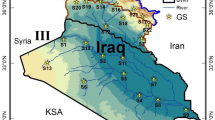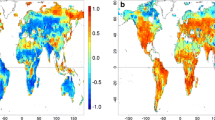Abstract
Even though existing remote-sensing-based drought indices are widely used in many different types of ecosystems, their utility has not been widely assessed in tropical dry forests (TDFs). The aim of this study is to evaluate the performance of three remote-sensing-based drought indices, the Vegetation Condition Index (VCI), Temperature Condition Index (TCI), and Vegetation Health Index (VHI), for meteorological drought monitoring in TDFs using the moderate-resolution imaging spectroradiometer (MODIS) products. The correlation between the VCI, TCI, and VHI and multiple time scales of the Standardized Precipitation Index (SPI) (1, 3, 6, 9, 12, 15, 18, 21, 24 months) for each month (January to December) and each season (dry season, dry-to-wet season, wet season and wet-to-dry season) were conducted using the Pearson correlation analysis. We also correlated year-to-year changes of satellite-based drought indices with the changes of the in situ annual SPI (A_SPI) which provides annual information on the mean meteorological drought. The analysis reveals that the ability of these remote-sensing-based drought indices for meteorological drought monitoring varies with timing, and the TCI outperforms the VCI and VHI in terms of seasonal and annual scale. These remote-sensing indices performed well in monitoring meteorological drought in the dry season, poorly in the in the dry-to-wet season, and moderately in the wet season. The TCI performed best in monitoring meteorological drought in the wet-to-dry period, followed by VHI, whereas the VCI performed worst. All of these remote-sensing-based drought indices failed to detect drought in May during the green-up period and in September, October, and November when the water content in the root regions was abundant. Our results indicate that the evapotranspiration of TDFs is more sensitive than canopy greenness to detect meteorological drought. Results from this study increase the ability to provide real-time drought monitoring and early warnings of drought in TDFs.






Similar content being viewed by others
References
Allen CD, Macalady AK, Chenchouni H, Bachelet D, McDowell N, Vennetier M, Hogg ET (2010) A global overview of drought and heat-induced tree mortality reveals emerging climate change risks for forests. For Ecol Manag 259(4):660–684
Alley WM, (1984) The palmer drought severity index: Limitations and assumptions. Journal of Climate and Applied Meteorology 23(7):1100–1109
Amalo LF, Hidayat R (2017) Comparison between remote-sensing-based drought indices in east Java. Earth and Environmental Science 54(1):012009
Asner GP (1998) Biophysical and biochemical sources of variability in canopy reflectance. Remote Sens Environ 64(3):234–253
Bhuiyan C, Singh RP, Kogan FN (2006) Monitoring drought dynamics in the Aravalli region (India) using different indices based on ground and remote sensing data. Int J Appl Earth Obs Geoinf 8(4):289–302
Brown JF, Wardlow BD, Tadesse T, Hayes MJ, Reed BC (2008) The vegetation drought response index (VegDRI): A new integrated approach for monitoring drought stress in vegetation. GISci Remote Sens 45(1):16–46
Cao S, Sanchez-Azofeifa A (2017) Modeling seasonal surface temperature variations in secondary tropical dry forests. Int J Appl Earth Obs Geoinf 62:122–134
Cao S, Sanchez-Azofeifa GA, Duran SM, Calvo-Rodriguez S (2016) Estimation of aboveground net primary productivity in secondary tropical dry forests using the Carnegie–Ames–Stanford approach (CASA) model. Environ Res Lett 11(7):075004
Carter GA, Cibula WG, Miller RL (1996) Narrow-band reflectance imagery compared with thermal imagery for early detection of plant stress. J Plant Physiol 148(5):515–522
Castillo M, Rivard B, Snchez-Azofeifa A, Calvo-Alvarado J, Dubayah R (2012) LIDAR remote sensing for secondary tropical dry forest identification. Remote Sens Environ 121:132–143
Choat B, Jansen S, Brodribb TJ, Cochard H, Delzon S, Bhaskar R, Hacke UG (2012) Global convergence in the vulnerability of forests to drought. Nature 491(7426):752–755
Du L, Tian Q, Yu T, Meng Q, Jancso T, Udvardy P, Huang Y (2013) A comprehensive drought monitoring method integrating MODIS and TRMM data. Int J Appl Earth Obs Geoinf 23:245–253
Dutta D, Kundu A, Patel NR, Saha SK, Siddiqui AR (2015) Assessment of agricultural drought in Rajasthan (India) using remote sensing derived vegetation condition index (VCI) and standardized precipitation index (SPI). Egypt J Remote Sens Space Sci 18(1):53–63
Engelbrecht BM, Comita LS, Condit R, Kursar TA, Tyree MT, Turner BL, Hubbell SP (2007) Drought sensitivity shapes species distribution patterns in tropical forests. Nature 447(7140):80–82
Guttman NB (1999) Accepting the standardized precipitation index: A calculation algorithm. J Am Water Resour Assoc 35(2):311–322
Janzen DH (2000) Costa Rica's area de Conservacion Guanacaste: A long march to survival through non-damaging biodevelopment. Biodiversity 1(2):7–20
Ji L, Peters AJ (2003) Assessing vegetation response to drought in the northern Great Plains using vegetation and drought indices. Remote Sensing of Environment 87(1):85–98
Kalacska M, Sanchez-Azofeifa GA, Calvo-Alvarado JC, Quesada M, Rivard B, Janzen DH (2004) Species composition, similarity and diversity in three successional stages of a seasonally dry tropical forest. For Ecol Manag 200(1–3):227–247
Karnieli A, Bayasgalan M, Bayarjargal Y, Agam N, Khudulmur S, Tucker CJ (2006) Comments on the use of the vegetation health index over Mongolia. Int J Remote Sens 27(10):2017–2024
Karnieli A, Agam N, Pinker RT, Anderson M, Imhoff ML, Gutman GG, Goldberg A (2010) Use of NDVI and land surface temperature for drought assessment: Merits and limitations. J Clim 23(3):618–633
Kogan FN (1995) Application of vegetation index and brightness temperature for drought detection. Adv Space Res 15(11):91–100
Kogan FN (1997) Global drought watch from space. Bull Am Meteorol Soc 78(4):621–636
Kogan F (2002) World droughts in the new millennium from AVHRR-based vegetation health indices. Eos, Transactions American Geophysical Union 83(48):557–563
Li W, Cao S, Campos-Vargas C, Sanchez-Azofeifa A (2017) Identifying tropical dry forests extent and succession via the use of machine learning techniques. Int J Appl Earth Obs Geoinf 63:196–205
Lopezaraiza-Mikel M, Quesada M, Álvarez-Añorve M, Ávila-Cabadilla L, Martén-Rodríguez S, Calvo-Alvarado J (2013) Phenological patterns of tropical dry forests along latitudinal and successional gradients in the Neotropics. Tropical dry forests in the Americas:119–146
McKee TB, Doeskin NJ, Kleist J (1993) The relationship of drought frequency and duration to time scales. In: Eighth Conference on Applied Climatology, Anaheim, California, pp 179–184
Murphy PG, Lugo AE (1986) Ecology of tropical dry forest. Annu Rev Ecol Syst 17(1):67–88
Nichol JE, Abbas S (2015) Integration of remote sensing datasets for local scale assessment and prediction of drought. Science of the Total Environment 505:503–507
Olukayode Oladipo E (1985) A comparative performance analysis of three meteorological drought indices. Int J Climatol 5(6):655–664
Palmer WC (1965) Meteorological drought, US Department of Commerce. Research Paper 45:58
Patel NR, Chopra P, Dadhwal VK (2007) Analyzing spatial patterns of meteorological drought using standardized precipitation index. Meteorol Appl 14(4):329–336
Phillips OL, Aragão LE, Lewis SL, Fisher JB, Lloyd J, López-González G, Quesada CA (2009) Drought sensitivity of the amazon rainforest. Science 323(5919):1344–1347
Phillips OL, Van Der Heijden G, Lewis SL, López-González G, Aragão LE, Lloyd J, Dávila EA (2010) Drought–mortality relationships for tropical forests. New Phytol 187(3):631–646
Portillo-Quintero CA, Sanchez-Azofeifa GA (2010) Extent and conservation of tropical dry forests in the Americas. Biol Conserv 143(1):144–155
Portillo-Quintero C, Sanchez-Azofeifa A, Calvo-Alvarado J, Quesada M, do Espirito Santo MM (2015) The role of tropical dry forests for biodiversity, carbon and water conservation in the Neotropics: Lessons learned and opportunities for its sustainable management. Reg Environ Chang 15(6):1039–1049
Quiring SM, Ganesh S (2010) Evaluating the utility of the vegetation condition index (VCI) for monitoring meteorological drought in Texas. Agric For Meteorol 150:330–339
Quiring SM (2009) Developing objective operational definitions for monitoring drought. Journal of Applied Meteorology and Climatology 48(6):1217–1229
Rhee J, Im J, Carbone GJ (2010) Monitoring agricultural drought for arid and humid regions using multi-sensor remote sensing data. Remote Sens Environ 114(12):2875–2887
Rodriguez SC, Alvarado JCC, Santo MME, Nunes YR (2017) Changes in forest structure and composition in a successional tropical dry forest. Revista Forestal Mesoamericana Kurú 14(35):12–23
Sanchez-Azofeifa GA, Quesada M, Rodríguez JP, Nassar JM, Stoner KE, Castillo A, Cuevas-Reyes P (2005) Research priorities for Neotropical dry forests. Biotropica 37(4):477–485
Seiler RA, Kogan F, Sullivan J (1998) AVHRR-based vegetation and temperature condition indices for drought detection in Argentina. Advances in Space Research 21(3):481–484
Shamsipour AA, Zawar-Reza P, Alavi Panah SK, Azizi G (2011) Analysis of drought events for the semi-arid central plains of Iran with satellite and meteorological based indicators. Int J Remote Sens 32(24):9559–9569
Williams AP, Allen CD, Macalady AK, Griffin D, Woodhouse CA, Meko DM, Grissino-Mayer HD (2013) Temperature as a potent driver of regional forest drought stress and tree mortality. Nat Clim Chang 3(3):292–297
Zargar A, Sadiq R, Naser B, Khan FI (2011) A review of drought indices. Environ Rev 19:333–349
Zhang Y, Peng C, Li W, Fang X, Zhang T, Zhu Q, Zhao P (2013) Monitoring and estimating drought-induced impacts on forest structure, growth, function, and ecosystem services using remote-sensing data: Recent progress and future challenges. Environ Rev 21(2):103–115
Zhang L, Jiao W, Zhang H, Huang C, Tong Q (2017) Studying drought phenomena in the continental United States in 2011 and 2012 using various drought indices. Remote Sens Environ 190:96–106
Author information
Authors and Affiliations
Corresponding author
Additional information
Publisher’s note
Springer Nature remains neutral with regard to jurisdictional claims in published maps and institutional affiliations.
Rights and permissions
About this article
Cite this article
Zou, L., Cao, S. & Sanchez-Azofeifa, A. Evaluating the utility of various drought indices to monitor meteorological drought in Tropical Dry Forests. Int J Biometeorol 64, 701–711 (2020). https://doi.org/10.1007/s00484-019-01858-z
Received:
Revised:
Accepted:
Published:
Issue Date:
DOI: https://doi.org/10.1007/s00484-019-01858-z




